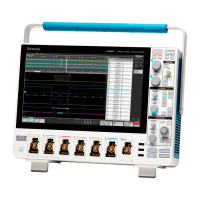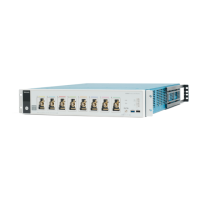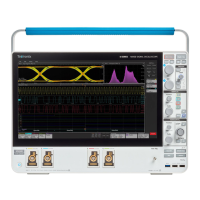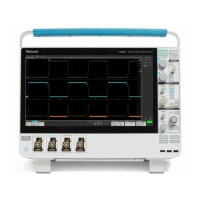Virtual Keypad
Use the virtual Keypad to enter numeric values and units for settings.
T
o open the virtual keypad, double-tap inside a field that requires numeric values.
Virtual Keypad fields and controls
Field or control Description
Clear Clears all values from the input entry field.
Exp Lets you enter exponential notation entries.
Max Enters the maximum value allowed for this setting.
Min Enters the minimum value allowed for this setting.
Bksp ← Deletes characters to the left of the insert text marker position.
Enter Closes the number pad and assigns the entered value to the field.
± Tap the button to set a numeric value to a positive (default) or negative value.
Unit buttons Use to set the units of the entered value.
Waveform View configuration menu
Use this menu to configure the W
aveform View to set display mode (Stacked or Overlay), waveform interpolation method, persistence, and
other parameters.
To open the Waveform View menu, double-tap anywhere in the Waveform View screen.
Waveform View menu fields and controls
Fields or controls Description
Display Mode Sets how waveforms are shown on the screen.
Overlay mode displays all waveforms on the screen, overlaid on each other
. This is the traditional way
that oscilloscopes displayed waveforms, and lets you overlay waveforms to do direct comparisons of
waveform shape. The grid vertical position and scale values change for each selected waveform.
Stacked mode draws each waveform in an individual section, or slice, of the screen, stacked one
on top of the other. This lets you view each waveform uncluttered by overlaying waveforms. Each
waveform slice displays its own vertical scale units. A trigger level indicator in a slice indicates that that
waveform is the trigger source.
Interpolation Selects the method used to display record points between sampled points.
Sin(x)/x computes record points along a curve between the actual acquired samples. This form
of interpolation is useful when acquiring rounded waveforms such as sine waves. It is good for
general-purpose uses but may introduce overshoot or undershoot in signals with fast rise times.
This interpolation is also useful for looking at high-frequency signals, especially where the frequency
components are just below the Nyquist frequency.
Linear computes record points between actual acquired samples using a straight-line fit. This
interpolation is useful for measuring waveforms with fast rise times, such as pulse trains.
Table continued…
Menus and dialog boxes
2 Series MSO MSO24 and MSO22 231
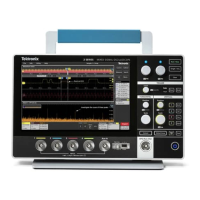
